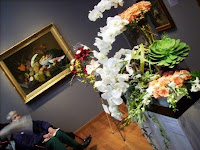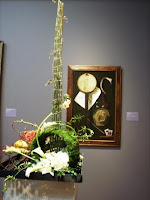 Improving gardening access
Improving gardening accessEarlier this month Page and volunteers completed installing this wooden hand rail to make it easier to go up and down our slope! I pondered the symbolism of the eye-catching primary colors painted on this rail designed for a more inclusive community: blue representing Heaven and yellow representing Earth for us humans in between? When I asked Tree, he said they just used whatever paint colors were available . . . okay, I’m really looking forward to our next step in making The Free Farm more inclusive: installing a garden bed table!

Here’s a model of a vegetable bed table at Garden For the Environment (
http://gardenfortheenvironment.org/). Tree and Page have reserved a (usually) sunny spot for our soon-to-be-constructed garden table between our container plants corner and the bench near where Joyce greets visitors entering The Free Farm.
"Save Your Back (and Your Greenbacks!) with a Garden Table” (
http://gardeningsolutions.ifas.ufl.edu/giam/news/pdfs/tablegarden_manatee311.pdf) describes a raised Garden Table designed to include those with mobility issues to enjoy gardening. Reading the part about the table being “easy to construct in about two hours” really spoke to me so I promptly emailed my request for instructions to Manatee Master Gardeners. Almost immediately, I received a response from Karen, who sent me instructions (
http://manatee.ifas.ufl.edu/lawn_and_garden/master-gardener/gardening-manatee-style/s/salad-table-box.pdf) along with a nice note of encouragement. She also related her County Extension office’s own fundraising efforts to install a new greenhouse and garden with a working Salad Table to demonstrate to the public how to grow and feed themselves!
In April, five of my horticulture classmates plan to join us at The Free Farm to begin working with Page on constructing our Garden Table. In the meantime, we’re looking for scavenged materials for this project: untreated, framing lumber (save trees via reuse!) and window screening. If you, or know someone who, can help, please contact
thefreefarm.sf@gmail.com. Thanks for your support in creating a more inclusive gardening community! (
http://thefreefarm.blogspot.com/2011/12/inclusiveness.html)
Advocating for growing spaceAccording to Briahn Kelly-Brennan, L.Ac., who teaches Traditional Chinese Medicine (
http://www.ccsf.edu/Resources/Faculty/bkelly/), the two most common organ imbalances in Americans relate to the spleen (poor diet) and liver
qi stagnation (stress due to unfulfilled desire). Yikes, I think nothing is more insufferable than stagnation—that feeling of being stuck . . . like stale air, compacted soil, anaerobic compost, caged wild animal . . .catch my drift? If you’ve been following this blog, I often write about the importance of access to good food, space in order to grow good food and connecting with nature. It’s about social justice and opportunity to reach our potential for community health. In this regard, The Free Farm has been a dream come true in fulfilling our desire for good food that makes up a healthy diet. Growing and eating our plants in our supportive community is so empowering, liberating, nourishing, eliminating
qi stagnation and rebalancing ourselves through good food + movement . . . so we’re
free to be you + me!
This past week Tree hosted a virtual Eating Meeting with the latest update about our growing space at Eddy/Gough. After Tree and Margaret met with representatives from Saint Paulus and Maracor (the developer that’s acquiring The Free Farm site) on Monday (
http://freefarmstand.org/2012/03/19/pretty-peas-peppers-and-a-permit-too/), Tree concluded that “we are now going to be more actively looking for a spot to relocate . . . Anyone that wants to be on a committee to help us find a new home would be welcome. This could be an exciting new change and challenge.”
Shortly after, my Getup classmate Susan (featured at
http://thefreefarm.blogspot.com/2011/09/our-spiritual-footprint.html) sent me an announcement for Food & Water Watch’s March 29th forum about Local Food & 2012 Farm Bill (see Public Service Announcement details below) with Supervisor and Land Use Committee Chair Eric Mar. Just before our new year (
http://thefreefarm.blogspot.com/2011/12/well-be-back-in-2012.html), I mentioned The Free Farm’s need for new growing space to Eric after he mentioned that his office was looking into vacant lots for community gardens . . . so we have an opportunity to gently remind him on March 29th :-) Now that Tree suggests we look for a new spot, let’s pull together some talking points.
Promoting health via prevention
In public health, we often talk about primary prevention strategies to most effectively improve community health. Earlier this year, I attended an all-day training, “Promoting Health, Safety, and Equity: Creating Systematic, Strategic and Sustainable Change,” presented by Prevention Institute (
http://www.preventioninstitute.org/) and hosted by Girls, Inc. (
http://www.girlsinc-alameda.org/) in San Leandro. (Yes, the same Girls, Inc. who artfully painted our toolshed during our inaugural ReFresh event at
http://thefreefarm.blogspot.com/2011/04/refresh-at-free-farm.html)
The U.S. health care system needs to shift its approach from a narrow biomedical/clinical (treatment after the fact, reactive, targeting individuals who are already sick/injured) to a broader
public health focus (large-scale
prevention in the first place,
proactive, emphasizing
community including the societal context, to avoid illness/injury). Primary prevention has potentially the greatest impact to improve health outcomes because it serves as the first level of defense to intercept causes of disease.
Our trainers discussed the “moving upstream” analogy that refers to understanding the cause of injury in order to prevent injury (e.g., finding that people are drowning due to falling through a hole in the bridge, so fixing the hole should prevent people from falling through in the first place). Of the four major determinants of health,
environment is the most influential, followed by behavior and lifestyle (others are heredity and health care services)—so we should focus on creating an environment that
supports healthy behavior and lifestyle choices. For example, we’re urged to ”make half your plate fruits and vegetables,” but what if plates are half empty because produce is not easily available/affordable in a neighborhood?
The top level of the Prevention Spectrum,
Influencing Policy and Legislation, has the potential for achieving broad impact on a community. By mandating what’s expected and required, policy can lead to behavior change that becomes the social norm in a community. In 2009, former Mayor Newsom directed that all city departments conduct an audit of unused land that could be converted into urban agriculture use. He was on target when he said, "Urban agriculture is about far more than growing vegetables on an empty lot. It's about revitalizing and transforming unused public spaces, connecting city residents with their neighborhoods in a new way and promoting healthier eating and living for everyone. . . There's no better preventative medicine and no easier way to reduce health care costs for the long term than teaching our residents and our children to eat healthier.” (
http://www.sfgate.com/cgi-bin/article.cgi?file=/c/a/2010/03/23/BA4V1CJP4C.DTL)
Practice makes perfect
One of the skill building exercises was to prepare a presentation to an imaginary local government council. After we were dealt a hand of cards as our talking points and evidence, we had to convince the government official to make our community health issue a local priority by taking an environmental approach to address the related exposures/behaviors and underlying community level factors.

It was so cool to hear from Nicki Guard, Girls, Inc. Volunteer Program Manager, as she eloquently made the case for community gardens as an investment in community level prevention by empowering residents as changemakers. She described how community gardens provide green spaces, bring people together to grow food so they learn the source of their nutrition, train people for a livelihood to sell produce at farmers’ markets, offer a safe place for the community to hang out, etc. Girls, Inc. Senior Director of Training Whitney Morris is seated across from Nicki.
Power of Community > Power of One

Prevention Institute Program Coordinator Dalila Butler reminded us about the effectiveness of community organizing and collaborating with like-minded partners. She referred us to free online training at
http://www.preventioninstitute.org/tools/partnership-tools.html.
We all need/want/desire good food locally —and the March 29 forum presents an exciting opportunity for interested parties to collaborate on how we can achieve our same objective in SF.
Public Service Announcement:
Thurs., Mar. 29, 2012, 6:30-8:30 pm Local Food & 2012 Farm Bill
Richmond Branch Library Community Room, 351 – 9th Ave. (between Geary & Clement), SF
Join Food & Water Watch for a special forum accompanied by a film screening of Antonio Roman-Alcala' s documentary "In Search of Good Food.”
About the Film:
“In Search of Good Food” (
http://insearchofgoodfood.blogspot.com/) features Antonio Roman-Alcalá, an urban farming activist from San Francisco, on his search for the "sustainable" food system in California. The film attempts to answer the question: Does the sustainable food system actually exist? And if it doesn't, what is preventing it from becoming reality?
Panel Members:
Eric Mar, District 1 Supervisor, Land Use Committee Chair (
http://www.sfbos.org/index.aspx?page=2083)
Adam Scow and Susan Kuehn, Food & Water Watch (
http://www.foodandwaterwatch.org/)
Paula Jones, Director of Food Systems, SF Department of Public Health (
http://www.sfgov3.org/index.aspx?page=753)
Christopher Cook, author of
Diet for a Dead Planet (
http://christopherdcook.com/).
SF Resolution:
Food & Water Watch and its allies have drafted a resolution urging the SF Board of Supervisors to pass a resolution calling upon California's U.S. Senators and Representatives to defend and advocate for initiatives that rebuild local and regional food infrastructure, support small and midsized producers and ensure that they are fairly compensated by buyers, promote sustainable and urban agriculture, increase access to healthy food, and connect more SF residents with local farmers and ranchers.
Why?
As many of you already know --our food system is not working for those who produce food or for those who eat it. Many farmers cannot make a living from farming, while many consumers lack access to healthy, sustainably-produced food. Conservation programs that help farmers steward our air, water, and climate are woefully underfunded. The infrastructure connecting farmers with consumers at the local and regional levels has all but disappeared. As a city with almost 1 million eaters, SF must ensure that important strides made in the 2008 Farm Bill to improve our food system are maintained in the 2012 budget and expanded upon in the upcoming 2012 Farm Bill.
Contact: Susan Kuehn 415.225.5916
March is National Nutrition Month
“Get Your Plate in Shape” campaign is based on USDA’s MyPlate at
http://www.eatright.org/NNM/.
Check out alternative Healthy Eating Plate at
http://www.hsph.harvard.edu/nutritionsource/healthy-eating-plate/healthy-eating-plate-vs-usda-myplate/index.htmlAccording to Food and Research Center (FARC), 9% of U.S. households with children report difficulty accessing affordable fresh fruits and vegetables at
http://frac.org/reports-and-resources/food-hardship-access-to-fruits-and-vegetables/, and 1 in 5 Americans report an inability to afford enough food; California’s Bakersfield and Fresno ranked 1st and 2nd in reporting about 25% hardship rates at
http://frac.org/reports-and-resources/food-hardship-data
 Before the screening of Antonio Roman-Alcala’s “In Search of Good Food,” Stephen mentions to Eric that he is working with Antonio (Alemany Farmer and Getup grad) to develop a new farm near The Food Bank in Potrero Hill.
Before the screening of Antonio Roman-Alcala’s “In Search of Good Food,” Stephen mentions to Eric that he is working with Antonio (Alemany Farmer and Getup grad) to develop a new farm near The Food Bank in Potrero Hill. Panelists: Eric Mar, Christopher Cook, Paula Jones, Susan Kuehn and Adam Scow. Paula and Susan are Getup grads!
Panelists: Eric Mar, Christopher Cook, Paula Jones, Susan Kuehn and Adam Scow. Paula and Susan are Getup grads! Bee visits California Poppy at SF Botanical Garden; Native Peoples used mashed stems and roots to relieve toothache.
Bee visits California Poppy at SF Botanical Garden; Native Peoples used mashed stems and roots to relieve toothache.


























































